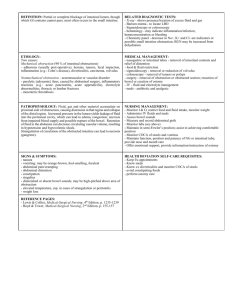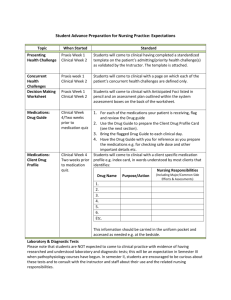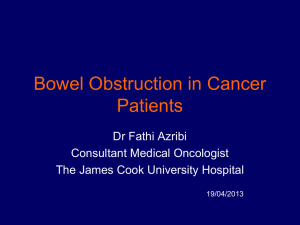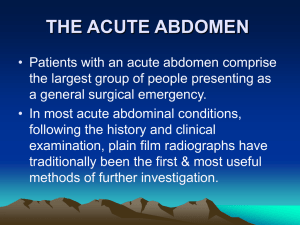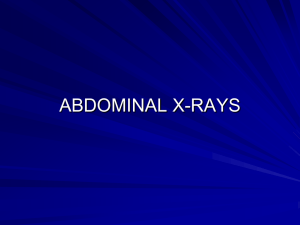223 kB - intestinal obstruction - anaesthetic concerns
advertisement
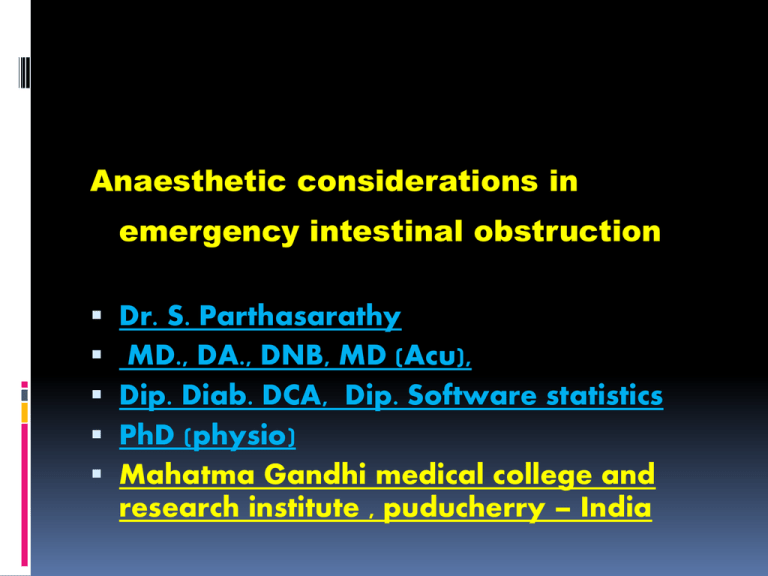
Anaesthetic considerations in emergency intestinal obstruction Dr. S. Parthasarathy MD., DA., DNB, MD (Acu), Dip. Diab. DCA, Dip. Software statistics PhD (physio) Mahatma Gandhi medical college and research institute , puducherry – India Incidence Intestinal obstructions account for about 20 percent of admissions to the hospital for abdominal disorders. Features of intestinal obstruction Abdominal pain Abdominal distension Obstipation vomiting Possible causes Hernia, Adhesions, Intussusption Ascaris Gangrene, Volvulus Growth. Stricture. Mechanical obstruction – correction usually surgical Laparotmy discussed now Laparoscopy later separate Preop problems Normal secretions Saliva - 1.5 litres Stomach – 2.5 litres. Succus entericus - 1.5 to 3 litres Pancreas – 750 ml Bile - 300 ml Total – 7 – 8 litres Clinically what is the loss? Early small bowel – 1.5 litres Well established with vomiting – 3 litres. Hypotension and hemodynamic instability -6 litres. Small and large Fluid derangement fast – small gut Slow in large gut Electrolyte imbalance slow in large gut Systemic derangement is progressive Except volvulus – no gangrene in large gut Where – obstruction – what happens? Pyloric obstruction causes a loss of H+ and Cl- (and Na+ and K+) due to vomiting acidic gastric secretions. Alkaline pancreatic and duodenal secretions are retained and the result is a hypochloraemic metabolic alkalosis Mid or high small bowel obstruction presents a different picture. Large volumes of fluid are lost (Na+, K+ and water) combination of alkaline intestinal secretions and acidic gastric secretions prevents the development of a metabolic alkalosis. In low small bowel obstruction and large bowel obstruction fluid loss tends to be less initially as much of the water and solute sepsis leads to circulatory collapse and metabolic acidosis. preop Fluid loss ------ shock Chloride loss Hypokalemia Hyponatremia May lead on to starvation, ketosis and acidosis preop If in shock and acidosis Possible intubation and ventilation Correct fluid deficits ,electrolytes and acidosis RL and NS with KCl – monitor CVP and urine output and correct The aim should be to correct the dehydration over 24 hours, giving half the calculated amount in the first 8 hours second half over the following 16 hours. If the patient is very hypernatremic (Na+ > 155mmol/ l) rehydration should be over 48 hours because of the risk of cerebral oedema Don’t look at the heroine alone Look at others also OTHERS Airway CVS RS CNS Spine etc ---- ROUTINE preop Gut mucosa – impermeable to bacteria Once strangulated , barrier breaks, toxins absorbed – septic shock Increased permeability also leads to loss of red cells into bowel and peritoneal cavity. Hence anemia To see Pulse BP CVP, acid base Routine blood , electrolytes ECG , urine output Hematocrit If hematocrit is 55 % then fluid loss is 40 % Hematocrit may be a guide to assess fluid infusion narcotics Narcotics Slow gastric emptying Affect peristalsis We can add anticholinergics to combat. INTRA ABDOMINAL HYPERTENSION The normal intra-abdominal pressure ranges from slightly sub-atmospheric to 6.5 mmHg, and varies with the respiratory cycle above 12 mmHg constitutes intra-abdominal hypertension(IAH). IAH ON CVS Haemodynamic compromise is due to complex alterations in preload, afterload and intra-thoracic pressure. A decrease in cardiac output is both due to : Increase in afterload secondary to mechanical compression of the abdominal vascular beds Decrease in preload due to direct compression of IVC and portal vein IAH INTRATHORACIC PRESSURE IMPEDES VENOUS RETURN ALSO GIVES FALSE CVP VALUES (BEWARE!) Respiratory effects Distended bowel and IAH Pressure on the diaphragm Inadequate ventilation Increase PCo2 decrease PO2 Increased risk of regurgitation HPV Increased plat. And peak pressures. Renal Oliguria is observed at intra-abdominal pressures between 15 and 20 mmHg, which can progress to anuria when pressures exceed 30 mmHg splanchnic decreased blood flow, microcirculatory abnormalities, ---- tissue hypoxia Except adrenals –blood flow Decrease Increased ICT premed Narcotics, benzo. and anticholinergics Preexisting tachycardia ? Acid aspiration prophylaxis Metoclopramide, Ryles tube aspiration Indwelling catheter. Monitors. Anaesthesia Controlled GA – ideal Epidural catheter with controlled GA is ok in selected cases Anaesthesia Ketamine?? If hemdynamically unstable Rapid sequence induction Precurarize before suxa ?? ET tube Anaesthesia Inhalational agents Rocuronium if possible?? N2O : O2 ? Air : O2 : inh. agent √ Problems of N2O bowel gas volume increases approximately 75–100% after 2 hours of 70–80% N2O, and by 100–200% after 4 hours. Intraop Monitoring Pulse, BP, CVP, ECG, Temperature, NMJ Urine output Blood loss, blood gases Think of sudden decompression sepsis Antibiotics And antifungal SOS Reversal Suggamadex -cyclodextrin -4 mg/kg. dose. Neostigmine can worsen anastomosis Atropine can cause undue hemodynamic disturbance Post op ventilation suggamadex suggamadex High spinal or epidural anaesthesia promotes hyper peristaltic activity - blockade of sympathetic innervation.s The unopposed parasympathetic activity may cause nausea and vomiting anastomotic breakdown, especially in colon surgery?? More theoritical? Postop Pain relief Tramadol, epidural drugs. Other narcotics. Atelectasis (AU 93) ILEUS Fluids and urine output In short, 6 litres fluid Electrolytes K +, Cl - , acid base Preop. vent. Controlled GA (with epidural) No N2O Blood SOS. Post op pain relief ,fluid
